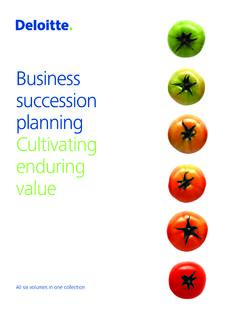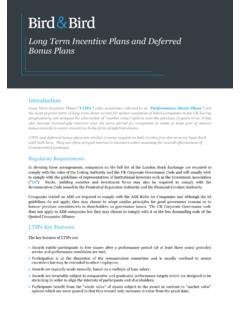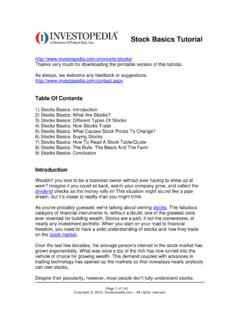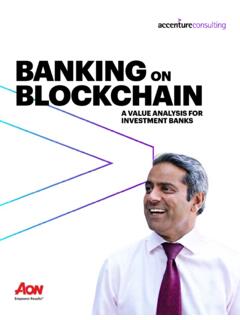Transcription of About the Tutorial
1 Supply Chain Management i About the Tutorial Supply Chain management can be defined as the management of flow of products and services, which begins from the origin of products and ends with the product s consumption at the end-user. This is a brief introductory Tutorial that explains the methodologies applied in the rapidly growing area of Supply Chain Management in an organization. Audience This Tutorial will be useful for students from management streams who aspire to learn the basics of Supply Chain Management.
2 Professionals, regardless of which sector or industry they belong to, can use this Tutorial to learn how to apply the methods of Supply Chain Management in their respective project environments. Prerequisites The readers of this Tutorial are expected to have a general idea of what supply chain management means and what place and importance it holds in an organization. Disclaimer & Copyright Copyright 2016 by tutorials Point (I) Pvt. Ltd. All the content and graphics published in this e-book are the property of tutorials Point (I) Pvt.
3 Ltd. The user of this e-book is prohibited to reuse, retain, copy, distribute or republish any contents or a part of contents of this e-book in any manner without written consent of the publisher. We strive to update the contents of our website and tutorials as timely and as precisely as possible, however, the contents may contain inaccuracies or errors. tutorials Point (I) Pvt. Ltd. provides no guarantee regarding the accuracy, timeliness or completeness of our website or its contents including this Tutorial .
4 If you discover any errors on our website or in this Tutorial , please notify us at Supply Chain Management ii Table of Contents About the Tutorial .. i Audience .. i Prerequisites .. i Disclaimer & Copyright .. i Table of Contents .. ii 1. SCM INTRODUCTION .. 1 Supply Chain Management Advantages .. 2 Supply Chain Management Goals .. 2 2. SCM PROCESS .. 4 Plan .. 4 Develop (Source) .. 4 Make .. 4 5 Return .. 5 3. SCM PROCESS FLOW .. 6 Types .. 6 Material Flow .. 6 Information Flow .. 7 Money Flow .. 7 4. SCM FLOW COMPONENTS.
5 8 Transportation .. 8 Warehousing .. 9 Sourcing and Procurement .. 10 Returns Management .. 10 Post-Sales 11 Supply Chain Management iii 5. SCM DECISION PHASES .. 12 Supply Chain Strategy .. 12 Supply Chain Planning .. 13 Supply Chain Operations .. 13 6. SCM PERFORMANCE MEASURES .. 14 Quantitative Measures .. 14 Non-Financial Measures .. 14 Financial 16 7. SCM STRATEGIC SOURCING .. 17 Understanding the Spend Category .. 18 Supplier Market Assessment .. 18 Supplier Survey .. 19 building the Strategy .. 20 RFx Request.
6 20 Selection .. 20 Communication with New Suppliers .. 20 8. SCM MAKE VS BUY .. 22 Business Strategy .. 23 Risks .. 24 Economic Factors .. 25 9. SCM: NETWORKS .. 27 Network Models .. 28 10. SCM INVENTORY MANAGEMENT .. 30 Role of Inventory .. 31 Optimization Models .. 31 Mixed Integer Linear Programming .. 31 Supply Chain Management iv Stochastic Modeling .. 32 Uncertainty Modeling .. 32 Bi-level Optimization .. 32 11. SCM PRICING & REVENUE MANAGEMENT .. 33 RM for Multiple Customer Segments .. 33 RM for Perishable Assets.
7 34 RM for Seasonal Demands .. 34 RM for Bulk and Spot Demands .. 35 12. SCM INTEGRATION .. 36 Push System .. 36 Pull 37 Differences in Push and Pull System .. 37 Push & Pull System .. 38 Demand-Driven Strategies .. 39 13. SCM ROLE OF IT .. 41 Electronic Commerce .. 41 Electronic Data Interchange .. 42 Barcode Scanning .. 43 Data Warehouse .. 43 Enterprise Resource Planning (ERP) Tools .. 43 14. SCM AGILE AND REVERSE SUPPLY CHAINS .. 45 Agile Supply Chain .. 45 Reverse Supply Chain .. 46 Supply Chain Management 1 Supply Chain Management can be defined as the management of flow of products and services, which begins from the origin of products and ends at the product s consumption.
8 It also comprises movement and storage of raw materials that are involved in work in progress, inventory and fully furnished goods. The main objective of supply chain management is to monitor and relate production, distribution, and shipment of products and services. This can be done by companies with a very good and tight hold over internal inventories, production, distribution, internal productions and sales. In the above figure, we can see the flow of goods, services and information from the producer to the consumer.
9 The picture depicts the movement of a product from the producer to the manufacturer, who forwards it to the distributor for shipment. The distributor in turn ships it to the wholesaler or retailer, who further distributes the products to various shops from where the customers can easily get the product. Supply chain management basically merges the supply and demand management. It uses different strategies and approaches to view the entire chain and work efficiently at each and every step involved in the chain.
10 Every unit that participates in the process must aim to minimize the costs and help the companies to improve their long term performance, while also creating value for its stakeholders and customers. This process can also minimize the rates by eradicating the unnecessary expenses, movements and handling. Here we need to note that supply chain management and supply chain event management are two different topics to consider. The Supply Chain Event Management considers the factors that may interrupt the flow of an effective supply chain; possible scenarios are considered and accordingly, solutions are devised for them.

















